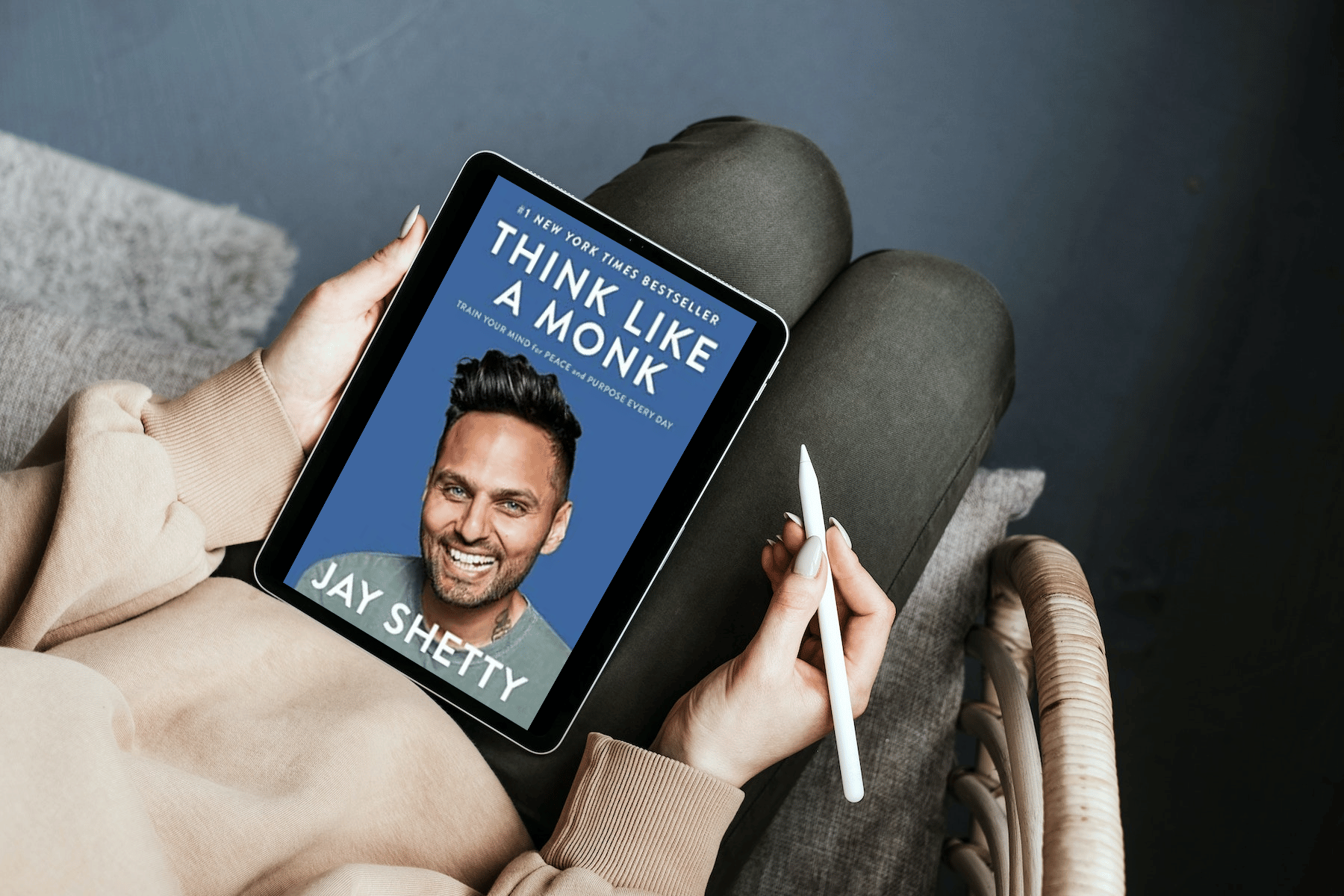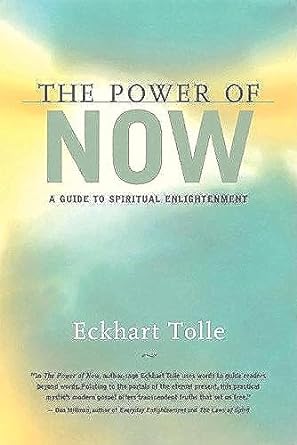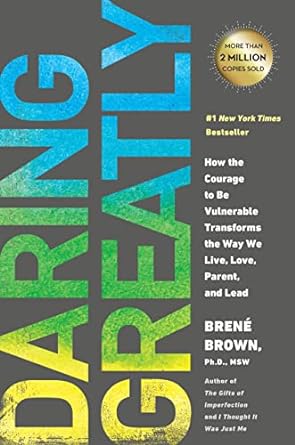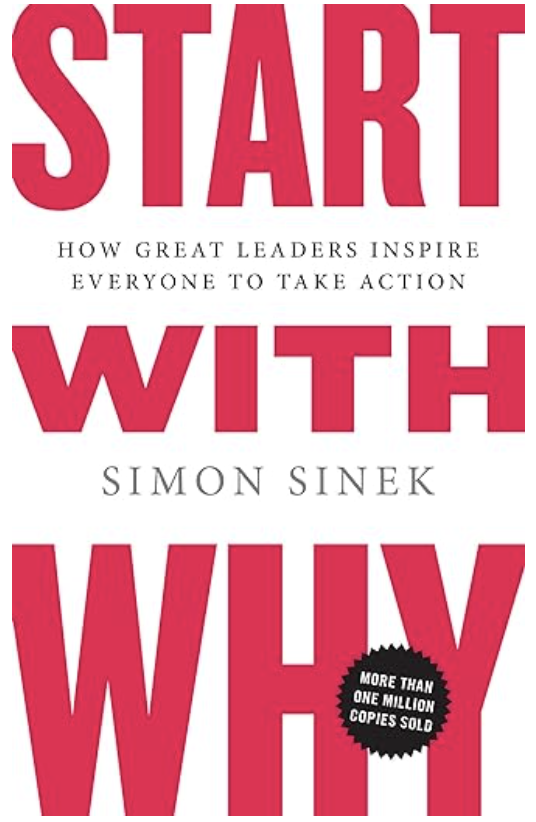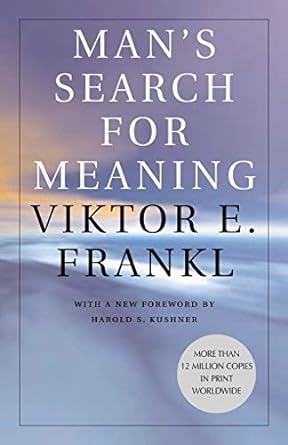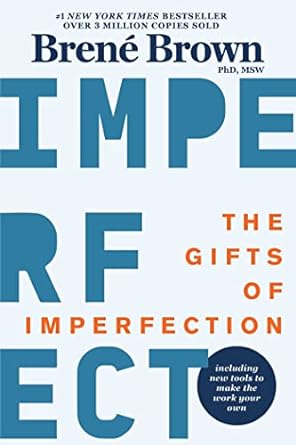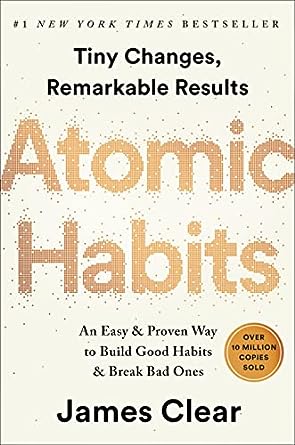Today, I’m taking you on a journey through the pages of Think Like a Monk by Jay Shetty.
If you’ve ever wondered how to find balance and purpose in the hustle and bustle of modern life, this will help.
Think Like a Monk has achieved significant success since its release.
It became a bestseller shortly after hitting the shelves, and it continues to receive positive feedback from readers and critics.
CLICK HERE TO BUY THINK LIKE A MONK ON AMAZON.
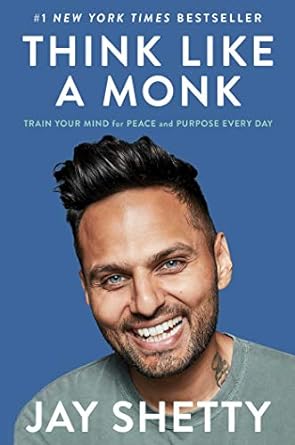
The Book’s Success
The book’s success can be attributed to its practical insights and relatable storytelling.
Jay Shetty’s approach to blending ancient wisdom with modern living has resonated with a wide audience seeking personal development and mindfulness.
The book’s impact can also be seen in its widespread influence on social media, where readers share their takeaways and implement the book’s teachings in their lives.
This has created a community of like-minded individuals striving for personal growth and inner peace.
Furthermore, Jay Shetty’s extensive online presence with viral videos, including his YouTube channel and podcast, has contributed to the book’s success by allowing him to reach a global audience with his message of mindfulness and purpose.
Who Is Jay Shetty?
Before we dive into the book, let’s get to know the author a bit.
Jay Shetty is a former monk turned motivational speaker and life coach.
His unique blend of ancient wisdom and contemporary insights has captured the hearts and minds of millions across social media.
In Think Like a Monk, he shares the lessons he learned during his time as a monk and how they can be applied to our daily lives.
Think Like a Monk by Jay Shetty Book Summary
What sets Think Like a Monk apart is its practicality.
Jay Shetty doesn’t just preach.
He provides actionable advice and exercises that you can incorporate into your daily routine.
Whether it’s meditation techniques, journaling prompts, or mindfulness practices, he offers tools to help you live with intention.
Below is a chapter outline and book summary for Think Like a Monk.

Chapter 1: The Power of a Monk Mindset
Chapter 1 serves as an introduction to the concept of a “monk mindset.” You will also learn about Jay Shetty’s personal journey from a monk to a motivational speaker.
Before we dive into the heart of the book, let’s acquaint ourselves with the author, Jay Shetty.
His incredible transformation from a monk to a renowned motivational speaker and life coach is nothing short of inspiring.
Shetty’s unique journey infuses Think Like a Monk with wisdom, bridging the gap between ancient philosophy and contemporary living.
A Glimpse into the Monk Mindset
The essence of this remarkable book is encapsulated in the concept of a “monk mindset.”
But what exactly does that entail?
In Chapter 1, Shetty unveils the power behind this mindset, one that has the potential to revolutionize our lives.
At its core, the monk mindset is an invitation to embrace stillness and inner reflection in a world characterized by chaos and constant motion.
It is an exploration of the transformative potential found in mindfulness, gratitude, and self-awareness – the very principles that monks have cherished for centuries.
Jay’s Journey: From Monkhood to Mastery
Shetty takes us on a profound personal journey as he recounts his transition from a life of monkhood to his current role as a sought-after mentor.
As we immerse ourselves in Shetty’s narrative, we gain valuable insights into the importance of slowing down, seeking silence, and finding meaning in simplicity.
It is through these practices that we discover our true selves and natural talents and unlock the dormant potential within.
Embracing the Monk Mindset: Why It Matters
Chapter 1 emphasizes the critical role of the monk mindset in our pursuit of peace and purpose.
By tapping into this mindset, we gain the ability to navigate the clamor of our daily lives with a newfound sense of clarity and tranquility.
It’s an approach that encourages us to look inward, where the seeds of contentment and fulfillment lie.
A Glimpse of What Lies Ahead
As we conclude our exploration of Chapter 1, we’re left with a sense of anticipation.
Think Like a Monk promises a transformative journey filled with practical wisdom and actionable advice.
In the chapters that follow, we’ll delve deeper into discovering our purpose, taming the ego, and cultivating gratitude.
Chapter 2: Discovering Your Purpose
In Chapter 2, Jay explores the idea of finding one’s purpose in life. He shares practical exercises to help readers discover their own purpose.
Chapter 2 is all about one of life’s most profound questions: What is our purpose?
Shetty begins by acknowledging that this question often looms large in our minds.
He recognizes the importance of discovering our purpose as a key element in finding fulfillment and meaning in our lives.
Going Beyond Career and Titles
Shetty emphasizes that our purpose isn’t limited to our careers or job titles.
Instead, he invites us to look deeper within ourselves to uncover our true calling and the unique contributions we can make to the world.
It’s a call to align our actions with our authentic selves.
Practical Exercises for Self-Discovery
What sets Think Like a Monk apart is its practicality, and Chapter 2 is no exception.
Shetty provides readers with actionable exercises to facilitate the journey of self-discovery.
These exercises help us tap into our passions, values, and talents to unearth our purpose.
Reflecting on Your Life
One of the key exercises involves reflecting on different aspects of your life, from the experiences that have shaped you to the things that truly matter to you.
This introspection helps you gain clarity about your core values and what drives you.
Discovering Your Dharma
Shetty introduces the concept of “dharma,” a Sanskrit word that refers to one’s duty or life’s purpose.
He guides readers in identifying their unique dharma, which serves as a guiding force for making decisions and living a more purposeful life.
The Power of Alignment
As we progress through Chapter 2, it becomes evident that discovering your purpose is not merely an intellectual exercise but a transformative journey.
When you align your life with your purpose, you experience a sense of fulfillment that goes beyond external achievements.
In summary, Chapter 2 of Think Like a Monk challenges us to look beyond societal expectations and discover the unique gifts we bring to the world.
Through practical exercises and true reflection, Shetty encourages us to embark on a profound journey of self-discovery and alignment.
Chapter 3: Letting Go of Ego
Chapter 3 discusses the role of ego in our lives. Jay Shetty shares strategies for taming the ego and finding inner peace.
Shetty kicks off Chapter 3 by shedding light on the often-overlooked but powerful force in our lives: the ego.
He explains how our egos can drive us to seek external validation, constantly compare ourselves to others, and undermine our sense of self-worth.
Identifying the Ego’s Tricks
One of the key takeaways from this chapter is the importance of recognizing when our ego is at play.
Shetty provides practical guidance on how to identify the ego’s influence on our thoughts and actions.
By understanding the ego’s tricks, we become better equipped to deal with it.
The Pursuit of True Self-Worth
Chapter 3 encourages us to shift our focus from external validation to finding our self-worth from within.
Shetty shares stories and wisdom from his time as a monk, illustrating how true self-worth comes from embracing our authentic selves and recognizing our intrinsic value.
The Practice of Detachment
Taming the ego often involves practicing detachment from our desires and attachments.
Shetty introduces the concept of “Vairagya,” a term from ancient Indian philosophy that encourages us to let go of our attachments and desires.
This practice can lead to a greater sense of inner peace and contentment.
Transformative Exercises
As with previous chapters, Think Like a Monk is not just a theoretical exploration but a practical guide.
Chapter 3 includes exercises to help us recognize and address our ego-driven behaviors.
These exercises empower us to cultivate a healthier sense of self and let go of the need for constant validation.
The Journey to Ego Mastery
In a nutshell, Chapter 3 encourages us to embrace humility, detach from external validations, and find our self-worth from within.
By taming the ego, we open the door to a more peaceful and authentic way of living.
Chapter 4: Training Your Mind for Peace and Purpose
This chapter is an introduction to mindfulness and meditation. It includes techniques for training the mind to cultivate peace and purpose.
In this chapter, Shetty delves into the profound world of mindfulness and meditation, offering insights and practical exercises to help us cultivate mental clarity and purpose in our lives.
The Journey Inward
Chapter 4 serves as a gateway to a deeper understanding of the monk mindset.
It encourages us to embark on a journey inward, where we can find stillness, self-awareness, and the transformative power of the mind.
Embracing Mindfulness
One of the central themes of this chapter is the practice of mindfulness.
Shetty introduces readers to the concept of being fully present in the moment, free from the distractions of the past and the anxieties of the future.
He emphasizes how mindfulness can lead to greater clarity, reduced stress, and enhanced overall well-being.
The Power of Meditation
Meditation practice takes center stage in Chapter 4.
Shetty shares his experiences as a monk, where meditation played a pivotal role in his daily routine.
He demystifies meditation, making it accessible to all, and offers practical guidance on how to incorporate meditation into our lives.
Practical Mindfulness Exercises
Think Like a Monk is not just a book of theory.
It’s a practical guide to personal growth.
Throughout Chapter 4, Shetty provides readers with mindfulness exercises that can be implemented in daily life.
These exercises help us train our minds to be more present, reduce stress, and find moments of clarity even amidst life’s chaos.
Cultivating Mental Clarity
A clear mind (the opposite of a monkey mind) is essential for finding purpose and inner peace.
This chapter invites us to clear the clutter from our mental landscape, allowing us to see our goals and values with greater clarity.
As we learn to quiet the noise of our minds, we create space for purpose to emerge.
Mind Training for Life’s Journey
In summary, Chapter 4 of Think Like a Monk guides us on the path of mind training.
It introduces the transformative practices of mindfulness and meditation, emphasizing their role in helping us navigate the complexities of modern life with a sense of purpose and inner calm.

Chapter 5: Overcoming Negativity
This chapter addressed negativity and self-doubt. You will learn tools for fostering a positive mindset.
In this chapter, Shetty delves into the pervasive issue of negative thoughts in our lives and offers practical strategies to foster a more positive mindset.
Understanding the Impact of Negativity
Chapter 5 commences by acknowledging the considerable influence negativity can have on our well-being and personal growth.
Shetty invites us to recognize the various forms of negative emotions, from self-doubt to external criticism, and their detrimental effects on our mental and emotional health.
The Importance of Self-Compassion
One of the central themes of this chapter is the significance of self-compassion.
Shetty emphasizes that before we can combat negative behaviors, we must first address the negativity within ourselves.
He encourages us to end negative self-talk and be kinder to ourselves, silence our inner critics, and cultivate a more positive self-image.
Shifting Our Focus
A pivotal lesson in Chapter 5 is the power of shifting our focus from negativity to positivity.
Shetty provides practical exercises and mindset shifts to help us reframe our thoughts and outlook.
By training our minds to see opportunities and silver linings in challenges, we can gradually reduce the impact of negativity.
The Role of Gratitude
Throughout Think Like a Monk, gratitude remains a recurring theme, and Chapter 5 is no exception.
Shetty underscores the role of gratitude in countering negativity.
He shares the transformative effects of practicing gratitude and provides exercises to incorporate it into our daily lives.
Surrounding Ourselves with Positivity
Shetty also emphasizes the importance of our environment in shaping our mindset.
He suggests evaluating our relationships and surroundings to ensure they contribute positively to our lives.
By surrounding ourselves with supportive, uplifting influences, we can better combat negativity.
Practical Steps Towards Positivity
In this chapter, Shetty equips us with practical steps to combat negativity, including journaling exercises, mindfulness practices, and techniques to foster self-love.
Cultivating a Positive Mindset
In summary, Chapter 5 of Think Like a Monk encourages us to cultivate positivity in our lives.
It provides us with the tools to address negativity both within ourselves and in our external circumstances.
By embracing self-compassion, gratitude, and positive thinking, we can pave the way for a more joyful and fulfilling existence.
Chapter 6: Relationships: The Key to Happiness
In this chapter, you will start exploring the significance of relationships in your life. Jay Shetty shares tips for nurturing healthy and meaningful connections.
In this chapter, Shetty explores the profound significance of relationships in our lives and offers insights on how to nurture and cultivate meaningful connections.
The Role of Relationships
Chapter 6 opens by emphasizing the vital role that relationships play in our pursuit of happiness and purpose.
Shetty acknowledges that our connections with others are fundamental to our well-being and personal growth.
The Quality of Our Connections
One of the central themes of this chapter is the importance of the quality of our relationships over quantity.
Shetty invites us to reflect on the people in our lives and assess the depth and authenticity of our connections.
He stresses that meaningful relationships are built on trust, empathy, and open communication.
The Impact of Toxic Relationships
In Chapter 6, Shetty also addresses the detrimental effects of toxic relationships.
He provides guidance on how to identify and navigate toxic dynamics, emphasizing the importance of setting boundaries to protect our emotional well-being.
Practical Tips for Nurturing Relationships
Shetty offers actionable advice and exercises to help us strengthen our connections with loved ones.
He encourages us to express gratitude, engage in active listening, and practice forgiveness as a means to foster healthier relationships.
Finding Balance
Shetty also emphasizes the importance of finding balance in our relationships.
He discusses how we can maintain our individuality and pursue our own goals while still being present and supportive of our loved ones.
The Impact of Service
Service to others is another key theme in Chapter 6.
Shetty shares the joy and fulfillment that come from helping and contributing to the well-being of others.
Acts of kindness and service, he suggests, can enhance our relationships and bring us closer to our purpose.
The Journey of Relationship Mastery
In summary, Chapter 6 underscores the value of meaningful connections and better relationships, offers guidance on navigating toxic relationships, and provides practical tips for nurturing and strengthening our bonds with others.
Chapter 7: Work with Meaning
This chapter will discuss the importance of meaningful work. Jay Shetty shares strategies for aligning your career with your purpose.
In this chapter, Shetty explores the connection between our work and our sense of purpose, offering insights on how to align our careers with our inner calling.
The Quest for Meaningful Work
Chapter 7 delves into the significant role that our careers and work play in our lives.
Shetty recognizes that finding purpose in our professional lives is a universal aspiration, and he offers guidance on how to infuse meaning into our work.
Moving Beyond the Paycheck
One of the central themes of this chapter is the idea that hard work should go beyond merely earning a paycheck.
Shetty invites us to reflect on our careers and consider how they align with our values, passions, and sense of purpose.
He emphasizes that meaningful work is about making a positive impact and finding fulfillment in what we do.
Identifying Your Passion
To discover meaningful work, Shetty encourages readers to identify their passions and interests.
He shares practical exercises to help us pinpoint the activities and causes that truly resonate with our hearts.
The Concept of “Ikigai”
Shetty introduces the concept of “ikigai,” a Japanese term that represents the intersection of what we love, what we are good at, what the world needs, and what we can be paid for.
It serves as a guide to finding our unique purpose in our professional lives.
Crafting Your Career with Purpose
Shetty offers actionable steps to help us infuse our careers with purpose.
Whether it’s finding a new job, starting a side project, or reimagining our current roles, he provides guidance on how to make work more meaningful.
The Fulfillment of Purposeful Work
In summary, Chapter 7 encourages us to move beyond the daily grind and seek careers that resonate with our passions and values.
By aligning our work with our sense of purpose, we can find deeper fulfillment and make a positive impact on the world.
Chapter 8: The Art of Gratitude
This chapter emphasizes the power of gratitude. Here, you will learn practical gratitude exercises to increase happiness.
In this chapter, Shetty explores the transformative power of gratitude and provides insights and practices to help us cultivate a more thankful and joyful life.
The Gratitude Shift
Chapter 8 opens by highlighting the incredible impact that gratitude can have on our lives.
Shetty acknowledges that we often focus on what we lack, but practicing gratitude shifts our perspective to appreciate what we have.
The Science of Gratitude
One of the central themes of this chapter is the scientific research and the basis of gratitude.
Shetty delves into the research that shows how gratitude can improve our mental and emotional well-being.
He explains how it can reduce stress, increase happiness, and enhance our overall quality of life.
The Practice of Gratitude
Shetty provides practical exercises and insights to help us incorporate gratitude into our daily lives.
He introduces the concept of gratitude journaling, where we regularly write down things we’re thankful for.
This simple practice can have a profound impact on our mindset and outlook.
The Attitude of Gratitude
A key takeaway from Chapter 8 is the importance of cultivating an attitude of gratitude.
Shetty encourages us to not only express gratitude for the big things but also for the small, everyday blessings that often go unnoticed.
This shift in mindset allows us to find joy in the present moment.
The Ripple Effect of Gratitude
Shetty discusses how gratitude has a ripple effect on our relationships.
When we express appreciation to others, it strengthens our connections and fosters a sense of belonging.
Gratitude, he suggests, is a powerful tool for building positive relationships.
Gratitude as a Way of Life
Shetty offers concrete steps to help us make gratitude a way of life.
By incorporating gratitude practices into our daily routines, we can experience the profound benefits of a thankful heart.
A Life Transformed by Gratitude
In summary, Chapter 8 underscores the importance of recognizing and appreciating the abundance in our lives.
By practicing gratitude, we can cultivate a more joyful and contented existence.
Chapter 9: Create a Daily Routine for a Balanced Life
This chapter designs a daily routine that promotes balance and well-being. Shetty shares tips for incorporating mindfulness into your everyday life.
In this chapter, Shetty explores the profound impact of daily routines and offers insights and practices to help us design a balanced and purposeful life.
The Power of Daily Routines
Chapter 9 opens by highlighting the transformative potential of daily routines.
Shetty acknowledges that our habits shape our lives and that a well-structured daily routine can lead to increased productivity, enhanced well-being, and a greater sense of purpose on a daily basis.
The Morning Routine
One of the central themes of this chapter is the importance of the first step – a morning routine.
Shetty explains how the first moments of our day set the tone for the rest of it.
For this, I love a to-do list. (It’s my personality type to love the small things like this.)
He provides practical guidance on how to create a morning routine that includes elements of mindfulness, gratitude, and self-care.
The Role of Mindfulness
Mindfulness is a recurring theme throughout Think Like a Monk, and Chapter 9 emphasizes its role in daily routines.
Shetty encourages us to incorporate mindfulness practices into our day, such as meditation or breathwork, to center ourselves and reduce stress.
The Impact of Gratitude
Gratitude also plays a significant role in daily routines.
Shetty discusses how starting our day with gratitude can shift our mindset and set us on a positive trajectory.
He suggests practices like keeping a gratitude journal or simply reflecting on the things we’re thankful for.
Balancing Work and Life
A key takeaway from this chapter is the importance of work-life balance.
Shetty advises us to set boundaries, allocate free time for work and personal life, and ensure that our routines include self-care and relaxation.
Creating a Personal Routine
Shetty offers actionable steps to help us create a personal routine that aligns with our goals and values.
He encourages us to experiment and adjust our routines until we find what works best for us.
A Balanced Life of Purpose
In summary, Chapter 9 underscores the importance of starting our days mindfully and with gratitude, as well as finding the right balance between work and personal life.
Chapter 10: The Monk in the World
In this chapter, you will learn how to apply the monk mindset to real-world situations. Shetty shares stories and examples of individuals who have transformed their lives.
In this chapter, Shetty invites us to apply the timeless wisdom of a monk mindset to our everyday lives and offers insights on how to navigate the complexities of modern existence with grace and purpose.
Translating Monastic Wisdom
Chapter 10 opens by acknowledging the challenges of implementing the principles of monkhood in our contemporary world.
Shetty recognizes that while we may not become actual monks, we can still embrace their wisdom and integrate it into our lives because it’s the right thing to do.
Applying Mindfulness in Daily Life
One of the central themes of this chapter is the practice of mindfulness in our everyday activities. Shetty emphasizes that mindfulness isn’t limited to meditation.
It can be applied to all aspects of life.
He provides practical guidance on how to infuse mindfulness into daily routines, such as eating mindfully or practicing deep listening in conversations.
Living with Purpose
Chapter 10 encourages us to approach our daily lives with purpose.
Shetty suggests that we should align our actions, decisions, and interactions with our core values and goals.
By doing so, we can find a deeper sense of fulfillment in our daily activities.
Overcoming Challenges
Life is not without its challenges, and Shetty acknowledges that even with a monk mindset, we will face difficulties.
However, he provides insights on how to approach challenges with resilience and a growth-oriented mindset.
Serving Others
Service to others is a recurring theme in Think Like a Monk, and Chapter 10 underscores its importance.
Shetty discusses how we can make a positive impact on the world by serving others, whether through acts of kindness or by sharing our knowledge and talents.
Continuing the Journey
Shetty offers actionable steps to help us embrace the monk mindset in our everyday lives. He encourages us to continually learn, adapt, and grow on our journey toward purpose and inner peace.
A Monk in the Modern World
In summary, Chapter 10 guides us in applying the wisdom of monks to our daily activities, fostering mindfulness, purpose, and service. By doing so, we can navigate the complexities of our contemporary lives with grace and authenticity.
Chapter 11: Embrace Your Monk Mindset
A summary on a summary! This chapter summarizes key takeaways from the book. Shetty gives encouragement to continue the journey toward inner peace and purpose.
In this final chapter, Shetty provides a summary of key takeaways and encourages us to continue our journey toward inner peace, purpose, and authenticity.
Reflecting on the Monk Mindset
Chapter 11 serves as a reflection on the profound journey we’ve undertaken throughout the book.
Shetty begins by summarizing the key concepts and practices explored in the previous chapters, reminding us of the transformative power of adopting a monk mindset.
The Ongoing Journey
While the book may be concluding, the journey toward a monk mindset is far from over.
Shetty encourages us to see this conclusion as the beginning of a lifelong path to personal growth and self-discovery.
The principles and practices we’ve learned are meant to be integrated into our daily lives continuously.
Living with Purpose
A central theme of this chapter is the key idea that we should live with purpose.
Shetty reminds us that purpose isn’t something we discover once and then forget about.
It’s an ongoing exploration.
He encourages us to continuously reassess our goals, values, and passions to ensure that we are living in alignment with our authentic selves.
The Power of Community
Shetty emphasizes the importance of surrounding ourselves with a supportive community.
Whether it’s a group of like-minded individuals or mentors who inspire us, community plays a vital role in our personal growth journey.
He suggests seeking out those who can provide guidance and encouragement along the way.
Embracing the Monk Mindset
In summary, Chapter 11 concludes our journey through Think Like a Monk by reminding us to embrace the monk mindset in our daily lives.
It serves as a call to action, encouraging us to continue the practices and principles we’ve learned and to never stop seeking inner peace, purpose, and authenticity.
As we wrap up Think Like a Monk, we recognize the book’s power in helping us embark on a transformative journey of self-discovery.
Shetty’s wisdom and practical guidance have provided us with invaluable tools for living a more mindful, purposeful, fulfilling, and happy life.
The conclusion of the book is not the end but the beginning of a lifelong quest for inner peace and authenticity.
CLICK HERE TO BUY THINK LIKE A MONK ON AMAZON.

In a world that often seems fast-paced and overwhelming, Think Like a Monk serves as a guide to finding peace, purpose, and happiness within ourselves.
Jay Shetty’s relatable storytelling and practical insights make this book a must-read for anyone on a journey of self-discovery.
It’s the best way to find yourself in a better place, with healthy relationships, and have better mental health.
Think Like a Monk is your roadmap to a more mindful and meaningful life with a new perspective.
Remember, the journey to inner peace is ongoing, but with the wisdom of this book as your companion, you’re well-equipped to navigate the path ahead.
Give it a read and let me know what you think on social media.
On Purpose with Jay Shetty
Reading this book isn’t the only way to live a better life.
If you don’t have spare time to read, you can listen to a podcast hosted by the book’s author.
Or, if you loved this great book, then the next step for better mental health can be in your ear buds.
The podcast, On Purpose with Jay Shetty, features a mix of solo episodes where Jay shares his insights, experiences, and wisdom, as well as interviews with a diverse range of guests.
His guests include thought leaders, experts, celebrities, and individuals who have inspiring stories to share.
The podcast covers a wide range of topics related to personal development, mindfulness, self-improvement, wellness, relationships, and spirituality.
Shetty draws on his experiences as a former monk and combines ancient wisdom with modern insights to provide actionable advice for his listeners.
Shetty’s podcast has a broad and diverse audience, including individuals seeking guidance on personal growth, self-improvement, and mental well-being.
It appeals to those looking for practical tips and philosophical insights to lead more fulfilling lives.
On Purpose with Jay Shetty has had a significant impact and has consistently ranked among the top podcasts in the self-help and personal development category.
Many listeners have praised Jay’s ability to simplify complex concepts and make them accessible for personal application.
Book Talks
If you enjoyed reading Think Like a Monk and are looking for similar books that explore personal development, mindfulness, and finding purpose, here are some recommendations along with brief descriptions of each book.
1. The Power of Now by Eckhart Tolle
This book explores the concept of living in the present moment and offers practical guidance on how to achieve mindfulness and find peace and purpose in the now. Buy it here.
2. The Monk Who Sold His Ferrari by Robin Sharma
Like Jay Shetty’s book, this novel explores the journey of a successful lawyer who gives up his career to seek enlightenment. It offers valuable life lessons and spiritual wisdom. Buy it here.
3. The Subtle Art of Not Giving a F*ck by Mark Manson
While this book has a different tone than “Think Like a Monk,” it delves into the importance of finding meaningful values, embracing life’s challenges, and living authentically. Buy it here.
4. Daring Greatly by Brené Brown
Brené Brown’s work explores vulnerability, shame, and the courage to be authentic. It’s an excellent choice for those interested in building meaningful connections and embracing vulnerability as a strength. Buy it here.
5. Start with Why by Simon Sinek
This book delves into the importance of understanding your “why” in life and work. It encourages readers to identify their core values and purpose to lead more fulfilling lives. Buy it here.
6. The Alchemist by Paulo Coelho
A timeless classic, this novel tells the real story of a shepherd named Santiago on his quest to discover his personal legend. It’s a beautifully written tale of following one’s dreams and finding purpose.
7. Man’s Search for Meaning by Viktor E. Frankl
This powerful book is based on Viktor Frankl’s experiences in Nazi concentration camps. It explores the human capacity to find meaning in the face of suffering and adversity. Buy it here.
8. The Gifts of Imperfection by Brené Brown
Another insightful work by Brené Brown, this book explores the importance of embracing imperfections and vulnerabilities as a means to live a wholehearted life. Buy it here.
9. Atomic Habits by James Clear
If you’re interested in personal growth and behavior change, this book offers practical advice on how to build positive habits, break bad ones, and make lasting changes. Buy it here.
10. You Are a Badass by Jen Sincero
This self-help book combines humor with motivational advice to help readers overcome self-doubt, embrace their inner power, and live a life they love. Buy it here.
These books cover a wide range of personal development and mindfulness topics, offering valuable insights and practical guidance for those seeking to enhance their lives, find purpose, and cultivate a mindset of growth and fulfillment.
To see what other great books I’m reading and loving, click here for blog posts on more books!
Happy reading, fellow monks in the making!
